Back-to-back stem-and-leaf
See: stem-and-leaf plot.
Bar chart
See: column graph.
Base
A base is a number which is the “building block” for a given number system. The choice of base determines the representation of numbers in that system. The most common bases used are binary and hexadecimal (base 2 and base 16, used for computing), octal (base 8) and decimal (base 10). An example of a decimal number is
![]()
An example of a binary number is ![]() . Converted to decimal, this would be:
. Converted to decimal, this would be:
![]()
Bernoulli trial
A trial where there is a probability ![]() of success and
of success and![]() of failure (sometimes also referred to as
of failure (sometimes also referred to as ![]() ) in any given trial.
) in any given trial.
An example could be the probability of an even number when rolling a dice. For every trial, the probability of success ![]() . The probability of failure (
. The probability of failure (![]() .
.
Note that the probabilities for success and failure add to 1 since ![]() .
.
See also: probability, trial.
Bimodal data
A data set is said to have a bimodal distribution of it has two modes. The term bimodal is also used if the graph of the distribution has two distinct ‘peak’ values, as shown in the histogram below:
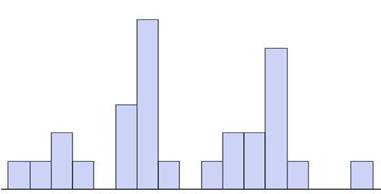
See also: mode.
Bivariate data
See: data.
Box-and-whisker plot
A box-and-whisker plot is a graphical display of a five-number summary (the minimum value, the lower quartile Q1, the median, the upper quartile Q3 and the maximum value).
In a box-and-whisker plot, the ‘box’ covers the interquartile range (IQR = Q3 – Q1), with ‘whiskers’ reaching out from each end of the box to indicate maximum and minimum values in the data set (formally, any data values a distance greater than 1.5 x IQR from the median are represented as individual data points). A vertical line in the box is used to indicate the location of the median.
The box-and-whisker plot below has been constructed from the five-number summary of the resting pulse rates of 17 students.
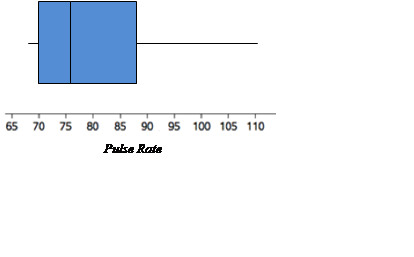
The term ‘box-and-whisker plot’ is commonly abbreviated to ‘box plot’.
See also: Five number summary
Box plot
See Box-and-whisker plot.
Branch (programming)
A branch occurs in a computer program which leads to different instructions being followed depending on a state at that branch point (e.g. true or false, a variable reaching a certain magnitude), that is, a decision is made. Examples of branching and decisions may be visualised more easily in a flowchart. See also: flowchart.
C
Capacity
Capacity is a term used to describe how much a container will hold. It is often used in relation to the volume of fluids. Units of capacity (volume of fluids or gases) include litres (L) and millilitres (mL). For example, the boot capacity of a typical hatchback car would be around 390 litres.
Cartesian coordinate system
The position of any point in the Cartesian plane can be represented by an ordered pair of numbers ![]() . These ordered pairs are called the coordinates of the point. This is called the Cartesian coordinate system.
. These ordered pairs are called the coordinates of the point. This is called the Cartesian coordinate system.
The point with coordinates (4, 2) has been plotted on the Cartesian plane shown. The coordinates of the origin are (0, 0).
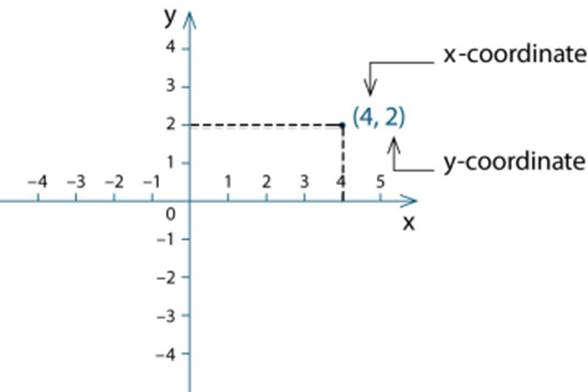
The Cartesian plane is divided into four regions, called quadrants, by the axes and origin of the coordinate system:
See also: Cartesian plane.
Cartesian plane
Two intersecting number lines are taken intersecting at right angles at their origins to form the axes of the coordinate system. The plane is then divided into four quadrants by these perpendicular axes called the ![]() -axis (horizontal line) and the
-axis (horizontal line) and the ![]() -axis (vertical line). This plane is called the Cartesian plane. See also: Cartesian coordinate system.
-axis (vertical line). This plane is called the Cartesian plane. See also: Cartesian coordinate system.
Categorical variable
A categorical variable takes values from sets which are not numerical.
For example, blood group is a categorical variable; its values are: A, B, AB or O. So too is construction type of a house; its values might be brick, concrete, timber, or steel.
Categories may have numerical labels too, for example, for the variable postcode the category labels would be numbers like 3787, 5623, 2016, etc., but these labels have no numerical significance. It makes no sense, for example, to use these numerical labels to calculate the average postcode in Australia.
See also: numerical data.
Census
A census collects information about the whole of a population. See also: population.
Chance and likelihood
The relative frequency of an event is the chance or likelihood of the event occurring. This may be expressed qualitatively using terms such as: impossible, no chance, not likely, an even chance, odds-on, likely, a certainty.
Relative frequencies may also be expressed quantitatively using numbers on a scale from 0 (impossible) to 1 (certain). These numerical values are often expressed as fractions such as ![]() , ratios such as 2:3, decimals such as 0.87 or percentages such as 40%.
, ratios such as 2:3, decimals such as 0.87 or percentages such as 40%.
See also: probability.
Chord
A chord is a line segment (interval) joining two points on the circumference of a circle. In the diagram below, the line segment QP is a chord.
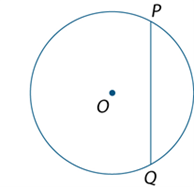
A chord is also a line segment joining two points on a curve:
See also: circumference, diameter, line segment.
Circle
A circle is the set of all points in the plane that are a fixed distance (the radius) from a given point (the centre of the circle). Sometimes ‘circle’ is used to refer to the closed curve, as in the circumference of a circle. At other times, it is used to refer to the entire shape, that is, the region including both the boundary and its interior.
A circle with centre O and radius OA of length r is shown in the following diagram.
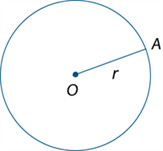
A circle can be constructed with a compass or dynamic geometry software, given the centre and radius of the circle, or three points which the circle passes through.
See also: chord, diameter, radius.
Circumference
The circumference of a circle is also used to refer to the measure of its perimeter. If the diameter or the radius of a circle is known, then its circumference is calculated as:
Circumference = p ´ diameter = 2 ´ p ´ radius
For example, using p » 3.14, the circumference of a backyard swimming pool with a 4 metre diameter is approximately 12.56 metres.
For a rough under-estimate, the value of p can be taken to be approximately 3. In this case the corresponding rough estimate for the circumference of the pool would be 3 ´ 4 =12 metres.
The circumference of a circle with unit radius is 2p » 6.28 units. See also: circle, perimeter.
Closure
The result of carrying out an operation on an element of a set, or elements of a set, is also an element of that set.
For example, multiplication is closed on the set of natural numbers, because the result of multiplying any pair of natural numbers is also a natural number. Division is not closed on natural numbers, since 9 and 2 are both natural numbers, but the result of dividing 9 by 2 is not a natural number. This is because ![]() , and
, and ![]() is a decimal fraction, not a natural number.
is a decimal fraction, not a natural number.
Coding
A process by which algorithms are represented for implementation. For computers, this is done using a coding language such as block coding, C++, JavaScript, Python, Wolfram Language. See also: implementation.
Co-domain
See: domain.
Coefficient
A coefficient is a constant which multiplies variables raised to positive integer powers. For example, in the expression ![]() , the variables are
, the variables are ![]() and
and ![]() and the coefficient is
and the coefficient is ![]() .
.
See also: constant.
Co-interior angle
Consider a transversal (line) intersecting a pair of lines (which may or may not be parallel). Angles which are formed at the intersection of these lines with the transversal, within the two lines, and on the same side of the transversal, are called co-interior (allied) angles.
An example of two co-interior angles are the angles ![]() and
and ![]() shown in the following diagram:
shown in the following diagram:
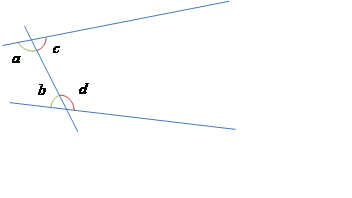
Note that the angles ![]() and
and ![]() would also be co-interior angles, but not the angles
would also be co-interior angles, but not the angles ![]() and
and ![]() because they are on different sides of the transversal. The angles
because they are on different sides of the transversal. The angles ![]() and
and ![]() would, however, be alternate angles.
would, however, be alternate angles.
If the pair of lines intersected by the transversal are parallel, then the sum of the angle measures of the two co-interior angles is 180°. Conversely, if the sum of the angle measures of the two co-interior angles is 180°, then the two lines intersected by the transversal are parallel. For example, in the diagram below, angle ![]() .
.
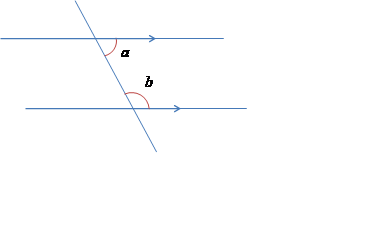
See also: angle, alternate angles, parallel, transversal.
Source: https://victoriancurriculum.vcaa.vic.edu.au/LearningArea/LoadFile?learningArea=mathematics&subject=mathematics&name=Mathematics%20Glossary.docx&storage=Glossary
Web site to visit:ttps://victoriancurriculum.vcaa.vic.edu.au
Author of the text: indicated on the source document of the above text
If you are the author of the text above and you not agree to share your knowledge for teaching, research, scholarship (for fair use as indicated in the United States copyrigh low) please send us an e-mail and we will remove your text quickly. Fair use is a limitation and exception to the exclusive right granted by copyright law to the author of a creative work. In United States copyright law, fair use is a doctrine that permits limited use of copyrighted material without acquiring permission from the rights holders. Examples of fair use include commentary, search engines, criticism, news reporting, research, teaching, library archiving and scholarship. It provides for the legal, unlicensed citation or incorporation of copyrighted material in another author's work under a four-factor balancing test. (source: http://en.wikipedia.org/wiki/Fair_use)
The information of medicine and health contained in the site are of a general nature and purpose which is purely informative and for this reason may not replace in any case, the council of a doctor or a qualified entity legally to the profession.
The texts are the property of their respective authors and we thank them for giving us the opportunity to share for free to students, teachers and users of the Web their texts will used only for illustrative educational and scientific purposes only.
All the information in our site are given for nonprofit educational purposes